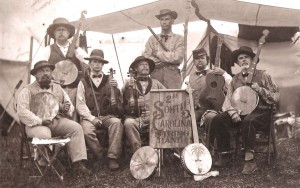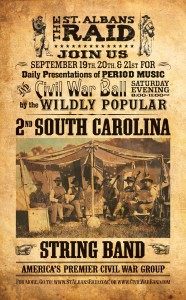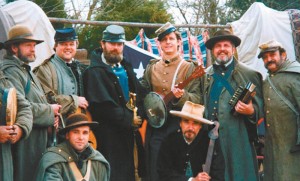ST. ALBANS — Song and dance were an important part of daily life, both at war and on the home front, during the Civil War era. They’ll also be a big part of the St. Albans Raid 150th Anniversary Commemoration.

The 2nd South Carolina String Band, will not only play during the St. Albans Raid 150th Anniversary Commemoration but will camp in Taylor Park as well.
The 2nd South Carolina String Band will perform Civil War-era music Saturday and Sunday, Sept. 20 and 21 in Taylor Park, and will lead the music and dancing during the Mayor’s Ball Saturday at 8 p.m.
How important was music and dance to the soldiers in the camps during the Civil War?
“Only a little less important than maybe food,” said Joe Ewers, band manager and banjo player for the band.
The 2nd South Carolina String Band was formed in 1989 by a group of five musicians from the Co. I, 2nd South Carolina Volunteer Infantry, a unit of Civil War re-enactors, who all happened to have the right mix of instruments — banjo, guitar, fiddle, tambourines, bones and military drum.
The band’s music has spread globally, and it has been featured in USA Today, People Magazine, and U.S. News & World Report. They’ve now released six albums, and have contributed soundtrack music to Ken Burns documentaries.
Ewers said there were primarily three types of music popular in that era: brass band marching music, sentimental pop music, and minstrel music.
Especially in winter, when roads were impassable and camps were stationary for months at a time, it was common to see elaborate dance halls constructed.
Ewers said he and his band like to play music from the minstrel stage. “We just start playing and that’s all it takes. People respond. Children, especially, respond to this music.”
 Meanwhile, etiquette was key for dancers during Civil War era balls, said St. Albans Historical Museum volunteer Jim Fouts, who has written about ballroom etiquette during the Civil War era.
Meanwhile, etiquette was key for dancers during Civil War era balls, said St. Albans Historical Museum volunteer Jim Fouts, who has written about ballroom etiquette during the Civil War era.
For example, said Fouts, no young ladies could attend a ball without the protection of married women or elderly gentlemen. It was considered rude to only dance with your spouse; dancing with everyone was encouraged.
“It was very formal,” Fouts said. “Bow, curtsy, lead the lady with right hand holding her right hand. Everybody wears gloves. It was rather fascinating,” Fouts said.
At the dances, a dance master and floor managers help organize and teach the steps. The Mayor’s Ball, too, will have assistants to manage the dancing.
“Without a floor manager, dance master, you can’t have a dance,” Fouts said.
Fouts also is assisting in decorating the ball, with red white and blue bunting and nine full-size division and brigade flags, all sewn by his wife, Carolyn Fouts.
There were dances for all classes and cultures back then, said Fouts. And it wasn’t uncommon for men to dance together, and even dress as women, especially in the war camps.
Whether anyone in attendance will take the Mayor’s Ball that far the evening of Sept. 20 remains to be seen.
More than whistling ‘Dixie’
Premier string band to enliven ball, park

The 2nd South Carolina String Band poses for a photo on the set of the film
Gods & Generals in 2004.
Joe Ewers called it “Kismet fate” that he and four other members of the Co. I, 2nd South Carolina Volunteer Infantry of Civil War re-enactors met in the late 1980s to form the 2nd South Carolina String Band.
Since then, the band has grown, and so has its devoted following, not to mention its members’ encyclopedic knowledge of Civil War-era song and dance.
The musicians will bring their talents to St. Albans the weekend of Sept. 20-21 playing in Taylor Park and at the Mayor’s Ball during the St. Albans Raid 150th Anniversary Commemoration.
Recently, Ewers, the band manager and banjo player, took time to discuss the culture of the music during the Civil War, both at home and in the camps, with the St. Albans Messenger.
The band members didn’t know each other when they met during the lead-up to the 125th Civil War anniversary proceedings as members of the newly founded infantry of Confederate re-enactors. The unit was formed, surprisingly, in Massachusetts, and originally it was just a small handful of guys playing their selection of instruments around the fire after a day of Civil War re-enacting at Fort Warren in Boston.
But the mix of instruments was the right one – banjo, fiddle, guitar, tambourine and percussion, and lead singer Dave Goss had an excellent memory of old Civil War classics from his youth, Ewers said.
Twenty-five years later, the band has been mentioned in a wide range of radio and print media, peaking with an appearance in the film “Gods & Generals” in 2004, as well as several Ken Burns documentaries.
“Music kept morale up,” said Ewers, explaining the importance of it during the Civil War. “We pick songs that reveal a little about the way of life. Talk about plantations, guys poling down the river with a bunch of tobacco, or a guy trying to drive a wagon from point A to point B and it breaks down, they are little glimpses of, I feel, anyway, real life in the 1840s and 50s.”
There were primarily three types of music during 19th Century, Ewers explained. There was the marching and brass band music. And there were two types of “pop” music: sentimental music and minstrel music. It’s the minstrel music the 2nd South Carolina String Band enjoys playing – tall tales of larger than life heroes and day-to-day living.
Sentimental music was more popular in the parlors on the home front, Ewers explained, while patriotic and minstrel music was more popular with soldiers.
Over 25 years, the band members began to discover music beyond the popular “Camptown Races” and “Battle Hymn of the Republic” and the widely-known Stephen Foster songs.
In Taylor Park Sept. 20 and 21, St. Albans Raid anniversary attendees can expect to see Ewers and the band set up in a Civil War winter camp-style tent and Ewers promises mini-performances anytime the mood strikes them.
“We set up underneath the fly and we start to play music that’s going to attract attention,” Ewers said. “Much of the music we play people will recognize and respond to. We do the songs, we explain what they are, we tell what the song is about, the history of the period.”
There will be two vocals at the period and formal-attire-only Mayor’s Ball Saturday night, Ewers said. And they’ll have to take into careful consideration their “Union” audience when picking a song.
“Southern Soldier and Dixieland, they burn the house down. Those two songs we do to close, especially in front of a friendly audience,” Ewers said before adding, “I doubt we’ll do Southern Soldier,” a song about a dead Union member.
With song, comes dance
To complement the music at the Mayor’s Ball, floor and dance managers will be present, much like traditional Civil War-era dances, to teach the steps. St. Albans Historical Museum volunteer and local resident Jim Fouts, whose generous contribution is helping make the ball a reality recently researched etiquette of the ball room and introductions.
While there were dances and balls for all classes of people then, it was still a class-conscious culture. Etiquette and formalities were as important as the dance steps, Fouts said.
“Without a floor manager and a dance master, you can’t have a dance,” Fouts said. “You have to have someone who knows what they’re doing.”
Fouts lists some examples of dances to expect at the ball: Soldier’s Joy, Virginia Reel, Lancer’s Quadrille and Spanish Waltz to name a few. “You have to be able to count to eight. Everything in sets of eight. And you have to know left from right. Gentlemen always step off with the left,” Fouts said.
Young ladies could not be in attendance without the “protection” of an elderly gentleman or married woman, Fouts said. Formal introductions could be made between acquaintances, but it was considered presumptuous to ask a stranger to dance.
It was considered rude, said Fouts, to only dance with your spouse beyond the first and last dance. A bow and courtesy was done at the conclusion of every dance.
In the winter, when infantry camps were stationary while roads were largely impassable, intricate, semi-permanent dance hall structures were often constructed. There, men thought nothing of acting as the female partner in dancing, and would even request articles of female clothing – hoop skirts, for example – to wear.
“When soldiers knew a dance was coming up, they would write home to their wives, sweethearts or mothers and ask for articles of women’s clothing,” Fouts said. “It was not unusual for half of the men in an organized event to portray the role of women. There was no shame in fellows dressing up as a woman and they’d have a ball.”
At the Mayor’s Ball on Saturday night, attendees can expect to find the ballroom decorated with red, white and blue bunting, and large full-size division and brigade replica flags representing the divisions Vermont troops fought in, sewn by Fouts’ wife, Carolyn.
That will be the backdrop as the 2nd South Carolina String Band plays, providing the soundtrack to the 150th anniversary commemoration weekend.
By JOEL LEHMAN
Messenger Staff




One Response to Life in 1864: Music & Dance